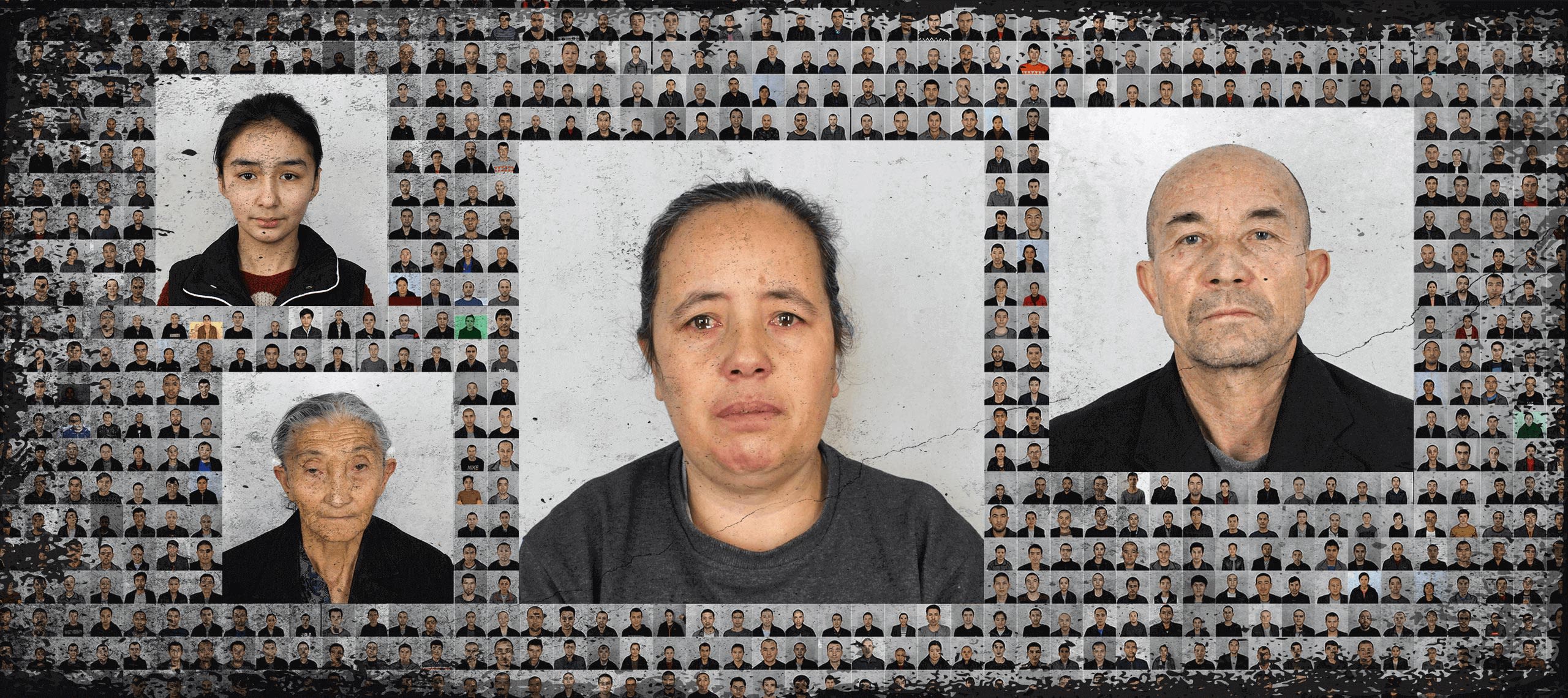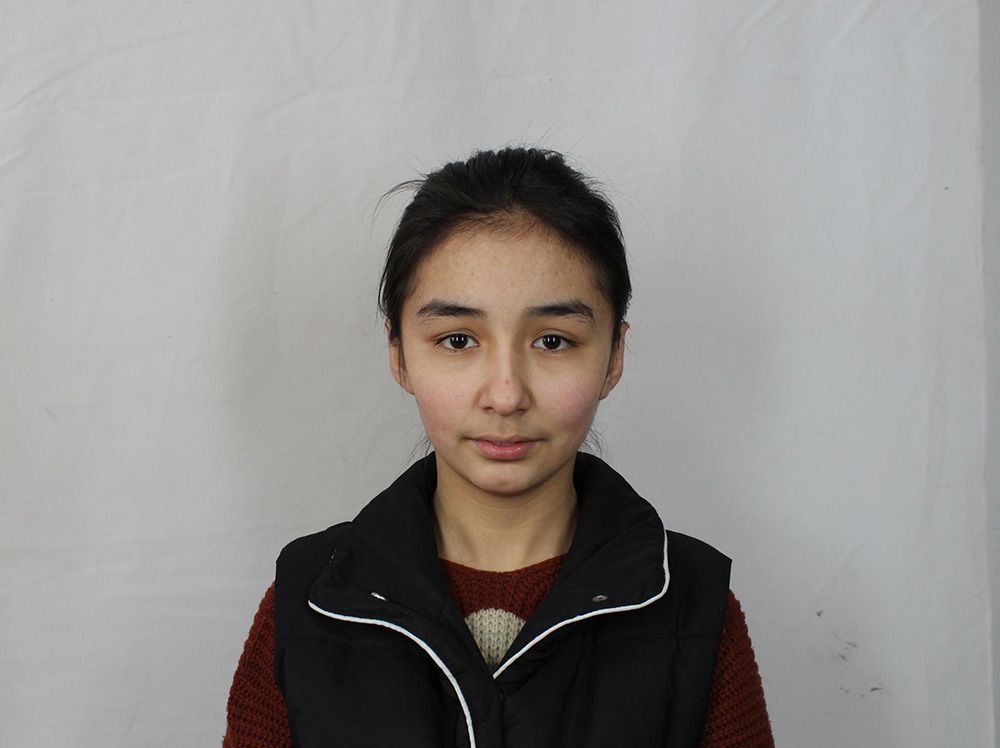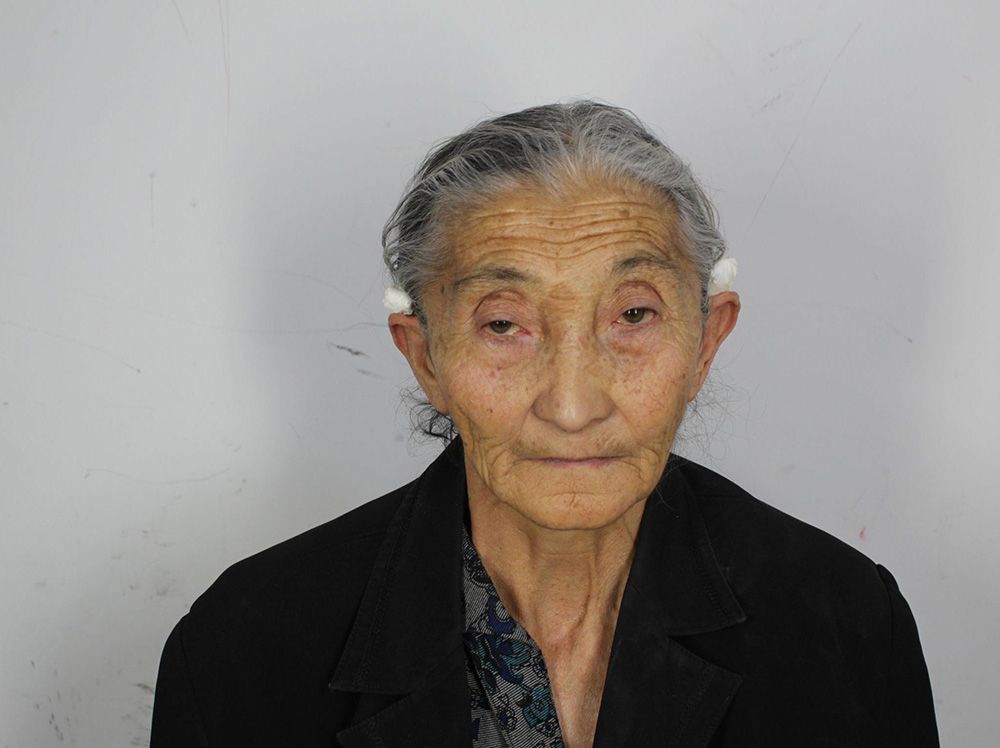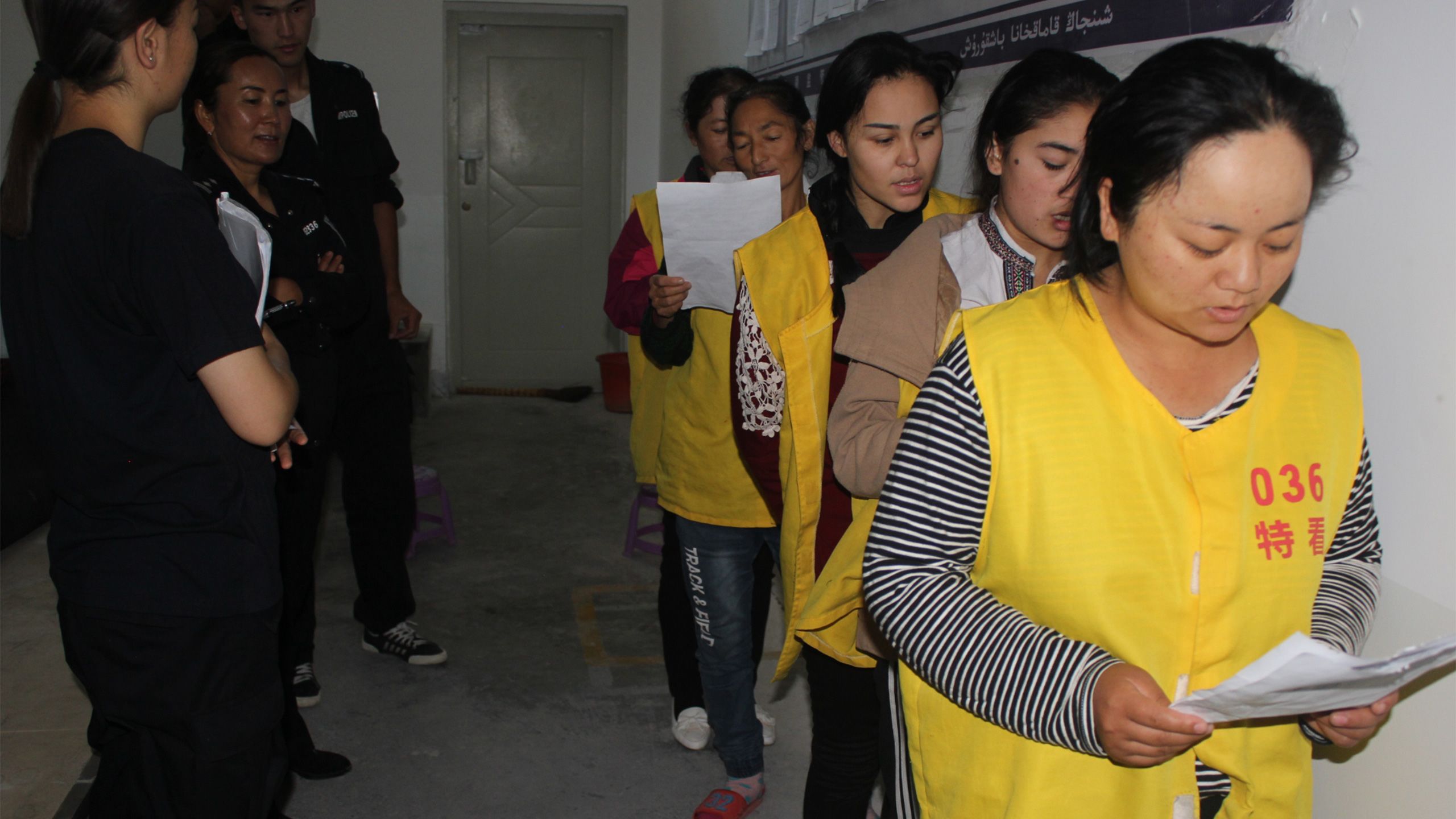The faces from China’s Uyghur detention camps

By John Sudworth
Thousands of photographs from the heart of China’s highly secretive system of mass incarceration in Xinjiang, as well as a shoot-to-kill policy for those who try to escape, are among a huge cache of data hacked from police computer servers in the region.
The Xinjiang Police Files, as they’re being called, were passed to the BBC earlier this year. After a months-long effort to investigate and authenticate them, they can be shown to offer significant new insights into the internment of the region’s Uyghurs and other Turkic minorities.
Their publication coincides with the recent arrival in China of the United Nations Human Rights Commissioner, Michelle Bachelet, for a controversial visit to Xinjiang, with critics concerned that her itinerary will be under the tight control of the government.
The cache reveals, in unprecedented detail, China’s use of “re-education” camps and formal prisons as two separate but related systems of mass detention for Uyghurs - and seriously calls into question its well-honed public narrative about both.
The government’s claim that the re-education camps built across Xinjiang since 2017 are nothing more than “schools” is contradicted by internal police instructions, guarding rosters and the never-before-seen images of detainees.
And its widespread use of terrorism charges, under which many thousands more have been swept into formal prisons, is exposed as a pretext for a parallel method of internment, with police spreadsheets full of arbitrary, draconian sentences.
The documents provide some of the strongest evidence to date for a policy targeting almost any expression of Uyghur identity, culture or Islamic faith - and of a chain of command running all the way up to the Chinese leader, Xi Jinping.
The hacked files contain more than 5,000 police photographs of Uyghurs taken between January and July 2018.
Using other accompanying data, at least 2,884 of them can be shown to have been detained.
And for those listed as being in a re-education camp, there are signs that they are not the willing “students” China has long-claimed them to be.
Some of the re-education camp photos show guards standing by, armed with batons.
Yet claims of coercion have been consistently denied by China’s most senior officials.
“The truth is the education and training centres in Xinjiang are schools that help people free themselves from extremism,” Foreign Minister Wang Yi said in 2019.
Many have been detained just for ordinary, outward signs of their Islamic faith or for visiting countries with majority Muslim populations.
With the threat of physical force again visible in the background, this woman’s photo highlights the widespread use of “guilt by association”.
Documents describe her son as having “strong religious leanings” because he doesn’t drink alcohol or smoke. As a result, he was jailed for 10 years on terrorism charges.
But she appears on a list of “relatives of the detained” - among the thousands placed under suspicion because of the “crimes” of their families.
The hacked files contain more than 5,000 police photographs of Uyghurs taken between January and July 2018.
Using other accompanying data, at least 2,884 of them can be shown to have been detained.
And for those listed as being in a re-education camp, there are signs that they are not the willing “students” China has long-claimed them to be.
Some of the re-education camp photos show guards standing by, armed with batons.
Yet claims of coercion have been consistently denied by China’s most senior officials.
“The truth is the education and training centres in Xinjiang are schools that help people free themselves from extremism,” Foreign Minister Wang Yi said in 2019.
Many have been detained just for ordinary, outward signs of their Islamic faith or for visiting countries with majority Muslim populations.
With the threat of physical force again visible in the background, this woman’s photo highlights the widespread use of “guilt by association”.
Documents describe her son as having “strong religious leanings” because he doesn’t drink alcohol or smoke. As a result, he was jailed for 10 years on terrorism charges.
But she appears on a list of “relatives of the detained” - among the thousands placed under suspicion because of the “crimes” of their families.
This composite image contains 2,884 photographs of detainees from the cache.
The photos provide a unique visual record of the way whole swathes of Uyghur society have been swept up - into both camps and prisons - person by person.

The youngest, Rahile Omer, was only 15 at the time of her detention.

The oldest, Anihan Hamit, was 73.
This composite image contains 2,884 photographs of detainees from the cache.
The photos provide a unique visual record of the way whole swathes of Uyghur society have been swept up - into both camps and prisons - person by person.

The youngest, Rahile Omer, was only 15 at the time of her detention.

The oldest, Anihan Hamit, was 73.
The Xinjiang Police Files - the title being used for the cache by a consortium of international journalists of which the BBC is part - contain tens of thousands of images and documents.
They include classified speeches by senior officials; internal police manuals and personnel information; the internment details for more than 20,000 Uyghurs; and photographs from highly sensitive locations.

An image from inside the rarely seen confines of a detention centre, which appears to show Uyghurs being “re-educated”
An image from inside the rarely seen confines of a detention centre, which appears to show Uyghurs being “re-educated”
The source of the files claims to have hacked, downloaded and decrypted them from a number of police computer servers in Xinjiang, before passing them to Dr Adrian Zenz, a scholar at the US-based Victims of Communism Memorial Foundation who has previously been sanctioned by the Chinese government for his influential research on Xinjiang.
Dr Zenz then shared them with the BBC, and although we were able to contact the source directly, they were unwilling to reveal anything about their identity or whereabouts.
None of the hacked documents is dated beyond the end of 2018, possibly as the result of a directive issued in early 2019 tightening Xinjiang’s encryption standards. That may have placed any subsequent files beyond the reach of the hacker.
Dr Zenz has written a peer-reviewed paper on the Xinjiang Police Files for the Journal of the European Association for Chinese Studies and he has placed the full set of detainee images and some of the other evidence online.
“The material is unredacted, it's raw, it's unmitigated, it's diverse. We have everything,” he told the BBC.
“We have confidential documents. We have speech transcripts where leaders freely talk about what they really think. We have spreadsheets. We have images. It's completely unprecedented and it blows apart the Chinese propaganda veneer.”
The Xinjiang Police Files contain another set of documents that go even further than the detainee photographs in exposing the prison-like nature of the re-education camps that China insists are “vocational schools”.

Xinjiang Police Files: Inside a Chinese internment camp
A set of internal police protocols describes the routine use of armed officers in all areas of the camps, the positioning of machine guns and sniper rifles in the watchtowers, and the existence of a shoot-to-kill policy for those trying to escape.
Blindfolds, handcuffs and shackles are mandatory for any “student” being transferred between facilities or even to hospital.
For decades, Xinjiang has seen a cycle of simmering separatism, sporadic violence and tightening government control.
But in 2013 and 2014, two deadly attacks targeting pedestrians and commuters in Beijing and the southern Chinese city of Kunming - blamed by the government on Uyghur separatists and radical Islamists - prompted a dramatic shift in policy.
The state began to see Uyghur culture itself as the problem and, within a few years, hundreds of giant re-education camps began to appear on satellite photos, to which Uyghurs were sent without trial.
Xinjiang’s formal prison system has also been massively expanded as another method for controlling Uyghur identity - particularly in the face of mounting international criticism over the lack of legal process in the camps.

It is in a set of 452 spreadsheets that this dual approach is most starkly exposed, complete with the names, addresses and ID numbers of more than a quarter of a million Uyghurs - showing which of them has been detained, in which type of facility and why.
They paint a picture of relentless internment in both camps and prisons, with row upon row documenting the prejudicial prying of Chinese officials sent deep into Uyghur society - backed with big data surveillance tools – to arbitrarily detain at will.
There are countless examples of people being punished retrospectively for “crimes” that took place years or even decades ago - with one man jailed for 10 years in 2017 for having “studied Islamic scripture with his grandmother” for a few days in 2010.
Many hundreds are shown to have been targeted for their mobile phone use - mostly for listening to “illegal lectures” or having encrypted apps installed.
Others are punished with up to a decade in prison for not using their devices enough, with well over a hundred instances of “phone has run out of credit” being listed as a sign that the user is trying to evade the constant digital surveillance.
The spreadsheets show how lives are sifted in search of the slightest of pretexts, which are turned into the broadest of charges - “picking quarrels” or “disturbing the social order” - and then punished as serious acts of terrorism; seven years, 10 years, 25 years, the columns of sentences stretch on and on.
If the terrorism label is ever justly applied, it’s impossible to discern among a sea of data pointing to the internment of a people not for what they’ve done, but for who they are.

Tursun Kadir’s spreadsheet entry lists some preaching and studying of Islamic scripture dating back to the 1980s and then, in more recent years, the offence of “growing a beard under the influence of religious extremism”.
For this, the 58 year old was jailed for 16 years and 11 months. Photographs in the cache show him both before and after the Chinese state determined his expression of Uyghur identity to be illegal.
Even for those not in a camp or prison, the Xinjiang Police Files reveal the gruelling impact of such high levels of scrutiny and surveillance.
The images show that Uyghurs still living in their homes were summoned in large numbers to be photographed, with the associated image timestamps showing whole communities - from the very elderly to families with young children - called into police stations at all hours, including in the middle of the night.

A similar file-naming system as that used for the photos taken in the camps and prisons suggests a possible common purpose - a huge facial recognition database that China was building at the time.
It’s hard to tell whether their faces betray the knowledge of the camps, into which many thousands were already disappearing, but the accompanying spreadsheets make the danger all too clear.
Five months after their police photos were taken in 2018, husband and wife Tursun Memetimin and Ashigul Turghun were sent to a detention centre after being accused of having “listened to a recording of an illegal lecture” on someone else’s mobile phone six years earlier.

Two of their three daughters’ photographs are also in the hacked files - Ruzigul Turghun, who was 10 at the time of their parents’ disappearance - and Ayshem Turghun, who was six.

The spreadsheets give few details about the fate of such children whose parents have both been detained.
It’s likely a significant number have been placed into the permanent, long-term care of a system of state-run boarding schools built across Xinjiang at the same time as the camps.
In fact, the closely shaved hair visible in so many of the images of children is a sign, overseas Uyghurs have told the BBC, that many are already made to attend such schools at least during weekdays, even if still under the care of one or both parents.
The photographs give human form to a policy designed to deliberately target Uyghur families as a repository of identity and culture and - in China’s own words - to “break their roots, break their lineage, break their connections, break their origins”.
As well as exposing the inner workings of China’s system of incarceration more clearly than ever before, the Xinjiang Police Files provide fresh clues about its scale.
Most of the spreadsheets relate to a county in southern Xinjiang, known as Konasheher in Uyghur, or Shufu in Chinese.
An analysis of the data by Dr Zenz shows that in just this one county, a total of 22,762 residents - more than 12% of the adult population - were in either a camp or a prison in the years 2017 and 2018.
If applied to Xinjiang as a whole, that figure would mean the detention of more than 1.2 million Uyghur and other Turkic minority adults - well within the broad range of estimates made by Xinjiang experts, which China has always dismissed.
Working with a consortium of 14 media organisations from 11 countries, the BBC has been able to authenticate significant elements of the Xinjiang Police Files.
Uyghurs living in Europe and the US were asked for the names and ID numbers of their missing relatives back home in Xinjiang. Multiple matches in the spreadsheet data were discovered, providing firm evidence that the information contains real people.
The BBC also asked Professor Hany Farid, an image-forensics expert at the University of California at Berkeley, to examine a subset of the photographs of Uyghur detainees.
He found no evidence that the images had been fabricated, with none of the usual tell-tale signs found in computer synthesised “deep fakes” nor any other indication of malicious, digital manipulation.
A strange effect visible on the edges of some of the images - as if they’ve been copied and then rotated slightly - can be explained in a way that also lends weight to the idea that they form part of China’s huge surveillance network in Xinjiang.
The glitches, Prof Farid believes, are likely to be the result of a commonly-used standardisation process for facial recognition databases, where any portraits that are slightly offset are automatically rotated to align the eyes with the horizontal.
“This is, of course, a completely innocuous manipulation,” he concluded in a written report for the BBC.
Further authentication can be provided by arranging the images in order of their accompanying timestamps and then observing the common details visible in the background, which show them to have been taken in real time and in real places.

After approaching the Chinese government for comment about the hacked data, with detailed questions about the evidence it contains, the media consortium received a written response from the Chinese Embassy in Washington DC.
“Xinjiang related issues are in essence about countering violent terrorism, radicalisation and separatism, not about human rights or religion,” the statement said, adding that the Chinese authorities had taken “a host of decisive, robust and effective deradicalisation measures”.
“The region now enjoys social stability and harmony as well as economic development,” it went on, saying that these things offer “the most powerful response to all sorts of lies and disinformation on Xinjiang”.
But there was no response to any of the specific evidence in the cache.
The Xinjiang Police Files contain another set of unique photographs that appear to only further highlight the extreme levels of physical control that Uyghurs are subjected to in the attempt to forcibly reengineer their identity.
They show what appear to be drills for subduing inmates - using similar methods to those described in the police documents for the camps - but this time in a detention centre.
There are also what look like indoctrination sessions, again showing the overlap between camps and prisons.
The descriptions on the back of the detainees’ uniforms place them at the Tekes Detention Centre in northern Xinjiang.
Satellite images of the exterior layout of this known detention facility in the city of Tekes…
…match perfectly with some of the photographs, making clear that the images are genuine and lending further credibility to the dataset as a whole.
The hacked files contain a number of speeches from high-ranking Party officials that allow an insight into the mindset behind the policies, as well as some of the clearest evidence so far for where responsibility ultimately lies.
In a speech, stamped as “classified” and delivered by Zhao Kezhi, China’s Minister for Public Security, on a visit to Xinjiang in June 2018, he suggests that at least two million people are infected with “extremist thought” in southern Xinjiang alone.

Peppered with references to President Xi Jinping, the speech heaps praise on the Chinese leader for his “important instructions” for the construction of new facilities and an increase in funding for prisons to cope with the influx in detainees necessary to reach that two million target.
And if the mass internment of Xinjiang’s Uyghurs and other Turkic minorities really does flow from orders given by the Chinese leader, then there are hints too about the kind of timeframe he has in mind.
The cache contains another secret speech, delivered in 2017 by Chen Quanguo - until recently Xinjiang’s hardline Communist Party secretary.
“For some, even five years re-education may not be enough,” he tells his audience of senior military and police cadres, a seeming admission that for as long as any Uyghur continues to feel a loyalty to identity or faith at least as strong as to the Party, there’s no end in sight.
“Once they are let out, problems will reappear, that is the reality in Xinjiang,” he says.
Credits
This report was entirely written, produced, edited and researched in Brussels, London, New York and Sweden by the BBC’s European, UK and US-based staff.
Author: John Sudworth
Producers: Kathy Long, Nyrola Elimä
Designers: Prina Shah, Sean Willmott
Online Producer: James Percy
Editor: Kathryn Westcott
Published: May 2022
More Long Reads


